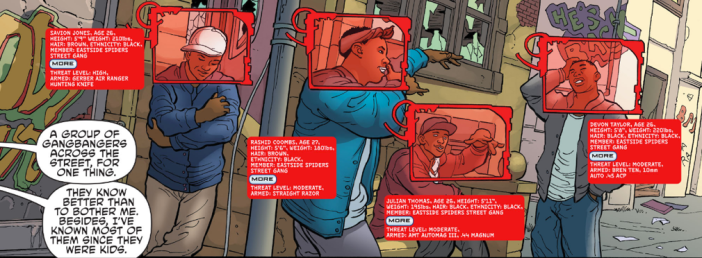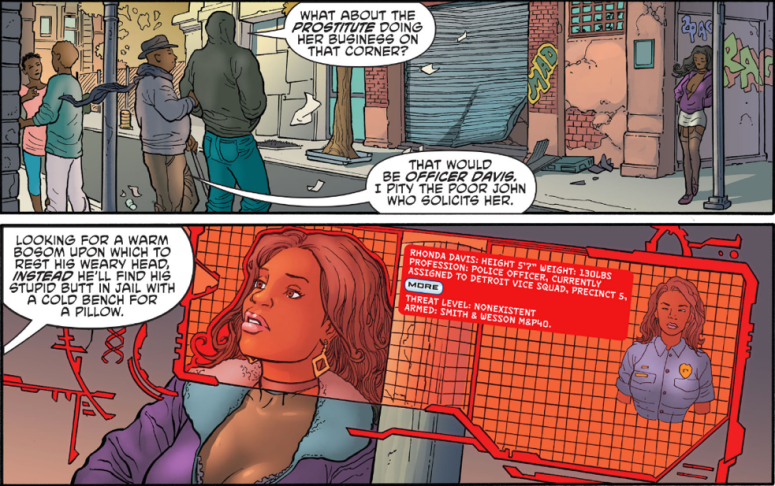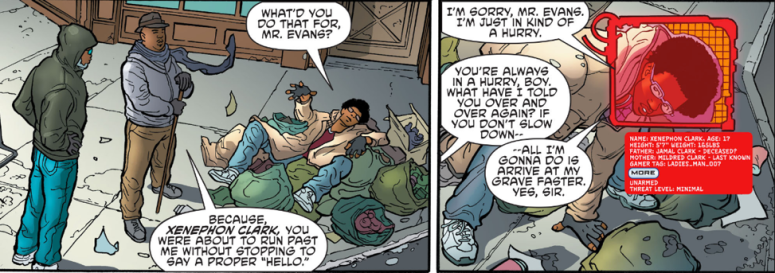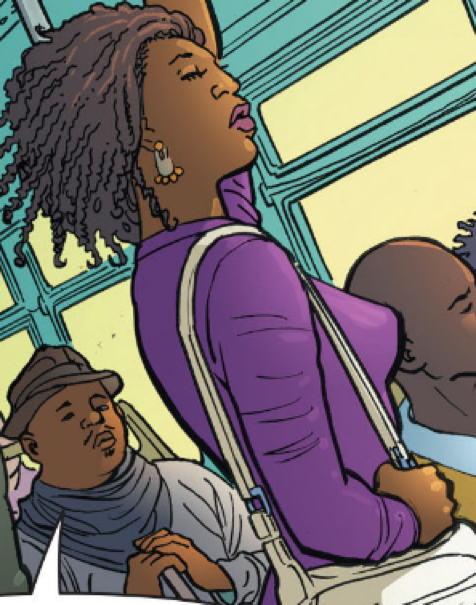John Semper Jr.’s Cyborg run is important for its societal implications and social commentary. Specifically, a scene in Cyborg (2016) #5, which takes less than ten pages to tell, interrupts the main plot of the ongoing series and places the reader in a situation that can remove comfort, disrupting the tone of the series by bringing racism into focus. While social issues play a role in Semper Jr.’s ongoing story, this scene stands out from the rest with its bluntness. In this essay, I’ll provide an analysis of John Semper Jr.’s metaphorical portrayal of being black in America in Cyborg #5. The scene I will discuss includes a conversation regarding black America’s diversity, blackness in the eyes of the white law, and the implications of the symbolic removal of blackness.
Cyborg is a superhero whose body is mostly machinery. Mortally wounded in an explosion, he was merged with technology to survive. In merging with machine, he became a cyborg. And in doing so, he may have become less of a person, a dilemma Cyborg is forced to deal with early on in this run.











The hoodie and sunglasses, for plot purposes, serve as a disguise for Cyborg, a celebrity due to his superheroism. In removing the disguise, he warns the officer to back off, for the officer is threatening a superhero and a man who could present more problems for the officer than the officer expected. Heeding the warning, the officers back off as Blue notes that “they sure left in a hurry.” But the hoodie also has a much deeper meaning: hoodies have become part of a black stereotype in the agenda pushed by a primarily white media and pop culture. Hoodies have also become a symbol of a movement pushing back against this oppressive aura. Brought on by the murders of innocent black men, such as Trayvon Martin, slain for looking “suspicious” in a hoodie, the hoodie has come to symbolize blackness and the imminent threat of execution of black men and women. When Cyborg removes his hoodie, the officer realizes he is harassing a superhero and quickly leaves. It’s important to note that the officer left because Cyborg is a superhero. One must recognize then, that the only way for a black man to not be treated as subhuman is to be a black superhero, an impossibility of reality. Occurring on the surface, this scene is straightforward, but the nuance of it brings a much more important and meaningful message.
When Cyborg removes his hoodie, he removes his metaphorical blackness and the oppressive stigma attached to him by being a “suspicious” black man in a hoodie. Once this particular form of blackness is removed, he can be looked at as a man by the officer and, by extension, the law. In removing his blackness, a part of himself, Cyborg isn’t just looked at as a man by the officer, he’s looked at as a “white” man, for the privileging stereotypes of white men include respect for police and authority, the opposite of the degrading stereotype that labels black men as “thuggish” and disrespectful. Cyborg’s blackness is both the same and different from other black Americans. As the reader now knows, Cyborg is his own black person, with a different life from every other black person. But his blackness also binds him to all of the black community through one shared experience: racism. And in removing his hoodie, a symbol of his blackness and the stereotype imposed on him, Cyborg demands respect from the officer.
The metaphor can be taken further, however. In previous issues, Cyborg has been established as a character facing an identity dilemma of man vs. machine. The subplot, bordering on the philosophical, asks what makes us human and how technologically far we can go before we’re more machine than human. This internal debate can be simplified into a more basic dichotomy of human vs not human. In doing so, the psychological stakes of the story are raised. For if Cyborg were to accept he is not human, he would not be human. Only in the constant reassurance of his humanity can he remain human. His body is almost entirely robotic and if the key human piece, the brain, were to fully accept his mechanization and therefore dehumanization, he would cease to exist as a human. This internal conflict furthers the nuance of the scene by showing the reader how black men are seen by the white law, even when forced to remove their blackness for survival. After Cyborg’s removal of his blackness, one would expect the officer to look at Cyborg as a human, but because the audience has been previously introduced to Cyborg’s internal dilemma, we have difficulty seeing Cyborg as entirely human. The massive piece of metal covering half his face is a concrete reminder of this perceptual problem: Cyborg cannot be seen as truly human when he does not look truly human. And at the same time, when we must see Cyborg as subhuman, the panel also looks over the officer’s shoulder at Cyborg, showing the way the officer views Cyborg. The audience’s perception, combined with the panel from the white officer’s perspective in looking at Cyborg, tells the audience that no matter what black humans do, in the eyes of white America, they are not entirely human. The only reason the officer then backs off is because of Cyborg’s superhero status which is impossible for black men to achieve in the real world. This creates a paradox: black men must remove a part of themselves to be treated as equal humans, but even in removing a part of themselves, they’re still seen as inferior. Not even Cyborg, a superhero embodying excellence, can be seen as equal. Although the police officer departs, he does not leave because he now sees Cyborg as equal; he leaves to avoid conflict with a superhero. This luxury (or privilege) cannot be enjoyed by non-superhero black men because they have no superpowers; the ones with the power are the white officers who control through threat of violence.
The diversity in the black community shown in the issue tells the audience that the black “thug” stereotype is detrimentally false, helping to hold the entire race down. The establishment of the hoodie as a symbol of blackness and its subsequent symbolic breaking of that blackness then tells the audience that the only way a black human can be seen as human in the eyes of the white law is by looking a certain way, fitting a white mold, that serves to take control and power away from the black body, black mind, and black soul. This disempowerment of black lives tells these black lives that they do not matter and that they are still owned, just not in the physical shackles their ancestors were forced to bear. But even when the blackness is willingly stripped away to fit the white mold, John Semper Jr. tells the reader that it doesn’t matter. No matter how hard a black human tries, they’re never seen as truly equal, never seen as truly human. In the end, we realize Blue was right: he should feel safe around his peers; the danger comes from the outsider, the white law. This scene is powerful and important, telling the reader the extent to which the oppression of the black human and the theft of the black life reach in America.

This run of cyborg sucked
LikeLike
I guess it sucks to you because his limbs aren’t getting destroyed like the previous versions.
LikeLike
Having read this I thought it was extremely informative. I appreciate you taking the time and effort to put this article together. I once again find myself personally spending a significant amount of time both reading and leaving comments. But so what, it was still worth it!
LikeLike
Hi there, after reading this awesome paragraph i am as well cheerful to share my know-how here with friends.
LikeLike